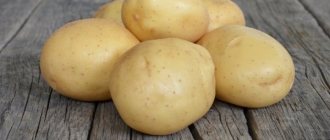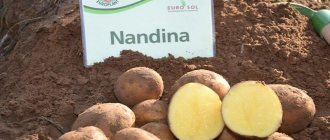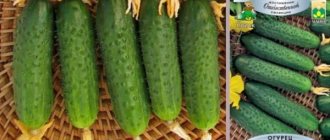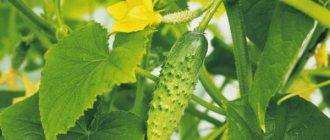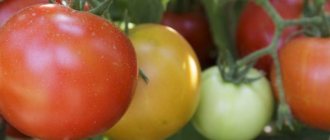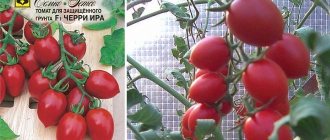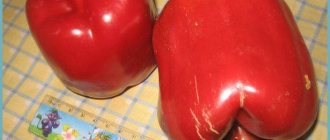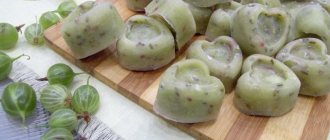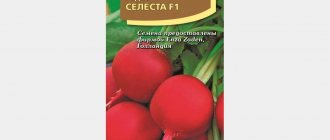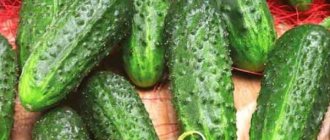» Vegetable growing » Cucumbers » Growing cucumber Forsazh
0
1987
Article rating
The Forsage cucumber is a hybrid that was bred not so long ago, but it has already become a favorite among vegetable growers. Gardeners choose it for its good growth performance in various climatic conditions, abundant harvest and ease of care.
- Features of cultivation
- Landing
- Care
- Diseases and pests
- Reviews from gardeners
Growing cucumber Forsazh
Description of Fast and Furious cucumbers
The plant is indeterminate and has good growth vigor. The variety is characterized by medium branching, the lateral shoots are of a determinant type, that is, they have limited growth force. The foliage of the cucumber is moderate. The leaf blade is angular-heart-shaped, with a slightly wrinkled surface, medium in size, long petiole. Female flowering type. According to the State Register, the number of female flowers in each Forsage node is 2 or 3; according to other sources, with sufficient care, up to 5 flowers can be formed.
Zelentsy are visually attractive, short, cylindrical in shape, evenly colored dark green, with medium-sized light stripes. The skin is not rough, elastic. The surface of the fruit is covered with large tubercles, the pubescence is white. The pulp has a pleasant consistency, tender, juicy, crispy. The taste is noted by the State Register as good. The seeds are at the stage of milky ripeness, so they are absolutely not felt during consumption. The sizing of cucumbers is excellent, they are almost one-dimensional, 10 - 12 cm long, 3.5 - 4.0 cm in diameter. Weight 110 - 130 grams.
What does a hybrid look like?
The Fast and Furious F1 cucumber was introduced to the world by Russian breeders at the beginning of this century. Compared to other varieties, the variety stands out for its productivity in any climate and on different soils.
The central stem grows without stopping. Under suitable conditions, the whip reaches 2 m in length. The number of side shoots is average. Unlike the central one, they stop growing on their own. Large leaves are held in place by long petioles. Flower type is female. In one node, the cucumber forms from 4 to 6 ovaries. The fruits are cylindrical, dark green in color, with pimples evenly distributed over the surface. The spikes are light (seen in the photo).
In the kitchen, cucumber is used mainly fresh. Small specimens up to 10 cm long are suitable for pickling.
| By type of growth | long-climbing |
| By type of branching | Medium branched |
| By type of pollination | Parthenocarpic |
| Planting scheme | 60x60 cm |
| Weight, length and shape of the fruit | 120-150 g, 10-15 cm, cylindrical, green |
| Ripening period | Early ripening (38-42 days) |
| Usage | Universal |
| Drop off point | exhaust gas/greenhouse/greenhouse |
| Diseases | Resistant to cucumber mosaic virus, powdery mildew, olive spot |
| Flowering type | Female |
| Productivity | In a greenhouse up to 17 kg/m²; in exhaust gas – up to 15 kg/m² |
Description of the plant
Several cucumbers can form in one ovary. The leaves are predominantly dark green. But, in some areas of the leaf, a light light green color is observed. The height of the bush can reach 2 m. This variety is characterized by an open type of flowering, predominantly female.
Description of the fruit
Forsazh f1 cucumbers are cylindrical in shape. Small pimples are formed on their surface, which are distributed evenly over the entire surface. Their color characteristic is predominantly white. The length of one fruit can reach 14 cm. But their weight reaches 150 g.
This variety of cucumbers is noted for its high yields. If they were planted in open ground, then the yield per 1 m2 is 12-15 kg. If they were planted in a greenhouse, then the harvest is about 17 kg.
It is a universal variety that is used in all activities of human life. It can be eaten raw or prepared in salads. It is also perfect for canning and salting. But the gherkins turn out crispy.
Photos of fruits
The following are photos of the Fast and Furious F1 cucumber:
Advantages and disadvantages
Advantages of a hybrid:
- Cucumber Forsazh F1 feels good almost throughout Russia.
- The plant does not require a specific soil composition.
- The hybrid begins to bear fruit early.
- The greens are attractive in appearance, tasty, and do not get crushed during transportation.
- To form an ovary, the cucumber does not need pollination (parthenocarpic type).
- The variety bears fruit throughout the growing season.
- Cucumber is endowed with high resistance to major crop diseases.
The disadvantage is the inability to obtain high-quality seeds.
Characteristics of the cucumber variety Forsazh
- Hybrid Forsage is an early ripening crop. After the emergence of full shoots, it will take only 38 - 42 days for the first crispy cucumbers to ripen;
- The fruiting period is long - from July to September;
- Fruiting is stable, marketable yield is excellent. The State Register provides data on 12.5 kg of cucumbers per 1 square meter, collected in film greenhouses;
- As befits hybrids, our hero has a strong immune system. Resistance to true and downy mildew, olive spot and cucumber mosaic virus is noted;
- Since the plant is intended for cultivation in protected soil, it is not afraid of any changes in weather conditions. But even in open ground, Forsazh proved to be quite resilient;
- Another important advantage for the successful cultivation of the variety in closed ground is the fantastic shade tolerance of the plant;
- despite the fact that cucumbers need to be picked on time, the greenery that lingers on the bush will not outgrow;
- parthenocarpicity is an ideal option for growing in a greenhouse and under film covers. This feature makes the hybrid completely independent of pollinating insects;
- transportability indicators are beyond praise. The presentation of the crop does not suffer during the longest transportation. Keeping quality, subject to storage standards, is also high;
- The way to eat greens is universal. Vitamin salads with the participation of Forsazh only benefit in taste and nutritional value, and housewives have already managed to appreciate the high quality of canned products from this variety.
Features of agricultural technology
Maximum yields are achieved only with the seedling growing method. For cultivation in a greenhouse, the time for sowing seeds for seedlings is early March. After growing 3 true leaf blades, the plants are distributed on the beds. The interval between plantings is up to half a meter.
Advice. If the soil is highly acidic, it is better to apply fertilizers containing lime in advance. This will create the best conditions for seedlings.
As the stem grows, the cucumber is tied up and shaped. In greenhouses, the central shoot is left. For this purpose, the first 3 leaves with adjacent stepsons and ovaries are removed. Subsequently, all the buds of the side shoots are cut off.
Sowing seeds for seedlings | Planting seedlings in a greenhouse/greenhouse | Planting seedlings in exhaust gas | Stepsoning | Harvesting (in the greenhouse / in the greenhouse) |
| End of March | End of April | The beginning of June | Starting from 1 sheet | Mid-June - until cold weather |
| *dates are indicated for central Russia | ||||
Features of planting Forsazh cucumbers
According to the description of the variety, Forsazh cucumbers grow well in both open and closed soil. The plant can be planted in any region of the Russian Federation.
Landing dates
It is recommended to plant Forsage cucumbers in the first half of March if the variety will be grown in greenhouse conditions. If the variety is grown in open soil, the seed is planted in early May, when the ground has warmed up to 17 degrees Celsius.
Site preparation
To grow Forsage cucumbers, you must choose a well-lit area that is protected from drafts. Particular attention should be paid to the soil of the site: sandy or loamy soils are chosen for the variety. To make the plant develop faster, sand is added to the soil.
The preparation of the land begins in the fall, when the beds are cleared of the predecessors of the variety. In autumn, the soil is carefully dug up, weeds are removed and it is fed with manure, wood ash and fertilizers with phosphorus and potassium.
Caring for Forsage cucumbers
Despite the fact that Forsazh cucumbers are unpretentious in care, the amount of harvest depends on compliance with the rules of watering, tying and shaping bushes, stable feeding and hilling. Let's consider a description of all care processes.
Watering
The variety has a developed root system, which ensures good absorption, which is especially important for saline soils.
The ideal solution for watering cucumbers would be a drip system with water taken from a container.
However, the hybrid requires abundant watering with warm water. It wouldn't hurt to use a drip system. During the growing season, it is recommended to carry out at least 4 fertilizations with fertilizer material. It is advisable to strengthen the developed immunity of the plant with preventive measures against diseases and garden pests.
Top dressing
Good yield of cucumbers is guaranteed by organic and mineral fertilizing, both root and foliar.
The former help accelerate the growth of the root, the latter nourish the stem.
Watering the plant is carried out in the evening, when the sun's rays are less hot, which prevents rapid evaporation of moisture. This will allow the soil to remain moist for a long time. Systematic loosening of the root zone will accelerate the growth and ripening of fruits, due to free access to oxygen and water.
Loosening the soil must be done after each watering or rain.
The variety loves moisture, but it should not be flooded.
Garter
Scheme for tying cucumbers to a wire trellis.
The plant is a climbing plant, so it should be tied to a trellis, which it is advisable to prepare in advance. When forming a stem at the lower three nodes, you need to remove shoots with ovary ovaries. On the fourth leaf, only the side shoots are removed.
Hilling
Many vegetable growers note that cucumbers are a crop that does not require hilling. This is due to the fact that the roots of the plant spread along the surface of the earth's crust. Therefore, as a result of hilling, it is possible to damage the root system of the plant and destroy it.
However, gardeners insist on loosening the soil with a pitchfork. This method will allow the necessary amount of oxygen to pass to the roots of the cucumbers and get rid of weeds.
Agricultural technology or proper cultivation: sowing seedlings with seeds, picking
The method and time of planting Forsage (F1) cucumbers depends on the location of the plant. Vegetables are planted in greenhouses in early March. The seeds are placed in pre-prepared soil to a depth of no more than 3 cm. Immediately after planting, the planting material should be watered with warm, settled water.
The distance between seeds should be at least 40 cm, and between rows - 50-60 cm. Planting in unprotected soil is carried out in early May, since the root system of the plant requires warm soil.
IMPORTANT: Experienced vegetable growers recommend adding mineral fertilizers with a high phosphorus content to the soil.
Planted cucumbers should be watered sparingly, preferably in the evening.
Harvesting and storage
The harvest begins in August. Since Forsazh is characterized by long-term fruiting, it is recommended to harvest every day so that the fruits do not interfere with the formation of new cucumbers. If you do not harvest daily, new cucumbers will slow down in development and take on irregular, ugly shapes.
Cucumbers must be stored in a cool room, the temperature of which does not exceed 4 degrees Celsius. As a rule, a basement or cellar is used for storage.
It is recommended to place cucumbers in wooden boxes so that the required amount of oxygen reaches the fruits. If one of the cucumbers begins to rot, it is necessary to review the entire box and eliminate not only the rotting fruit, but also its neighbors.
Pests and diseases
The early ripeness of the variety does not allow the use of potent agrochemicals. Such mixtures can lead to fruit toxicity. Most prophylactic solutions can be prepared at home using organic and mineral products:
- Powdery mildew is a common disease in cucumbers. The cause is hypothermia of the root system. The disease also occurs due to a greater amount of nitrogen in the soil. As a preventive measure, you should use a milk-based solution with the addition of iodine and soap.
- Increased humidity in the area leads to the appearance of peronosporosis. Fermented milk products will help prevent disease. They should be applied at the root of the bushes.
- White and gray rot affect the root system and stem. The cause is excess moisture. In the fight against the disease, a urea solution should be used. 10 g of product is diluted per 10 liters of liquid.
Diseases are less of a threat to hybrid varieties. Pests cause a lot of damage to bushes. Some of them attack the stems and root system. Others destroy the fruits.
The most common harmful insects are aphids and slugs. Pest prevention should be carried out in the fall, when preparing the soil for winter. Before frost, the soil should be dug up and left to freeze. This is to destroy pest larvae and weed seeds.
It is also recommended to plant onions and garlic between the rows. The smell of these plants repels many insects. Some farmers plant dill for the same purpose. Immediately before planting, the seeds should be calcined. This will strengthen the bushes' immunity.
Whitefly
Whitefly is a small pest of cucumbers that looks like a moth. The body of the insect has a yellowish color with whitish wings. Whiteflies usually appear in greenhouses. A pest invasion is determined by the following symptoms:
- The formation of a white coating on the surface of cucumber leaves;
- On the back of the leaves, yellow-white scales form - insect larvae;
- Cucumber leaves turn yellow and then turn black.
To get rid of whiteflies, vegetable growers use the chemicals Aktara, Verticillin and Fufanon.
Aphid
Aphids are a dangerous pest of cucumbers that are located on the underside of cucumber foliage. When aphids appear, the leaves of the plant curl, the stems become deformed, growth slows down, the ovaries fall off and the lower leaves wilt. To get rid of aphids, use the drug "Intavir".
Thrips
Thrips are insects that can cause damage to all vegetables. Thrips have wings, thanks to which they move freely from one bush to another. At the time of thrips invasion, a light stripe or holes are observed on the leaves.
Since it is extremely difficult to get rid of the insect, experts suggest immediately using the chemical preparations Fitoverm, Confidor, Intavir and Sprinter 240.
